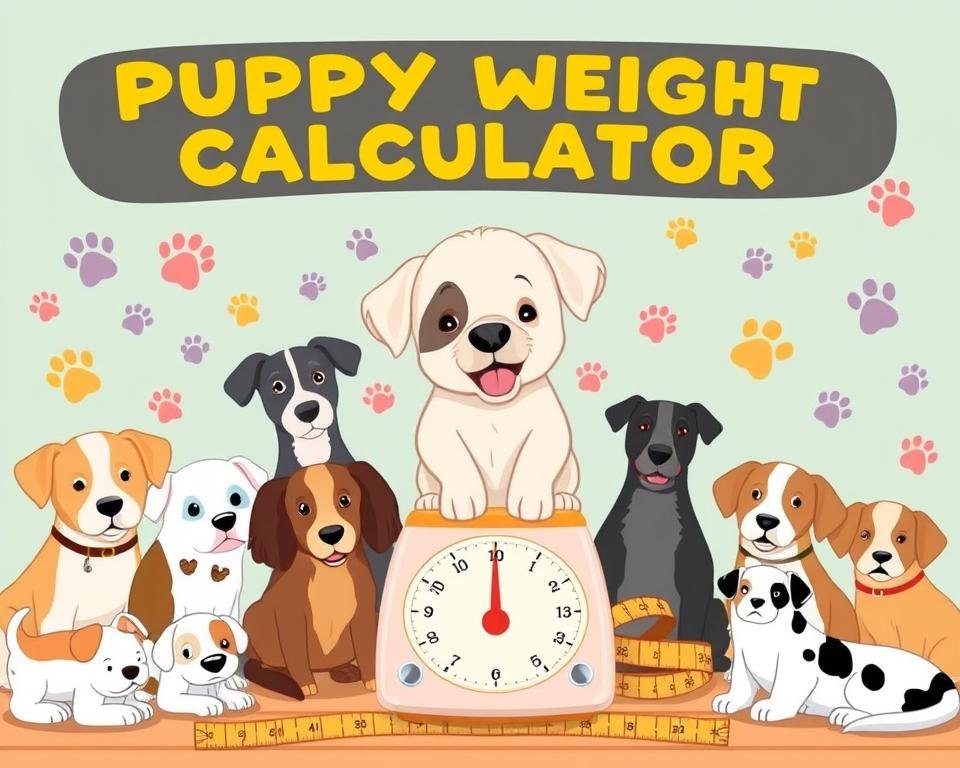Puppy weight calculators are key for pet owners to guess their puppy’s adult size. These tools use formulas based on the puppy’s weight, age, and breed. They help predict the puppy’s full-grown size.
Understanding how genetics, gender, diet, and exercise affect growth is important. This knowledge helps make the size estimates more accurate.
Knowing a puppy’s expected adult size is very helpful. It helps owners prepare by getting the right-sized crate and bedding. It also helps plan for the pet’s future food and care needs.
Accurate size prediction saves money and hassle. It lets owners make better decisions for their puppy’s needs.
Using a dog weight calculator or a puppy size prediction tool gives pet owners valuable insights. They can understand their pup’s future size better. This helps ensure their puppy grows into a healthy, well-adjusted adult.
With the puppy weight estimator, you can guess your puppy’s size. Knowing this helps keep your dog healthy and happy for life
Understanding Puppy Growth Factors
Several factors influence a puppy’s adult size. The breed of the dog is key, with purebreds showing more predictable growth. Genetics from the parents also play a big role in a puppy’s size.
Breed-Specific Growth Patterns
The breed of a dog is very important for its adult size. Purebreds usually follow consistent weight and height guidelines. Mixed breeds, with their mixed genetics, are harder to predict.
Impact of Genetics and Gender
A puppy’s size is shaped by its genetics. Male dogs are often larger than females. Spaying or neutering can also change a dog’s weight due to hormonal changes.
Role of Diet and Exercise
Good nutrition and exercise are vital for a puppy’s growth. A balanced diet helps them reach their full size. Regular exercise keeps them at a healthy weight.
Knowing these growth factors is key when using a dog size calculator. By looking at breed, genetics, and diet and exercise, you can make a better guess about your puppy’s size.
“A puppy’s size is determined by a complex interplay of genetics, diet, and exercise – all of which must be carefully considered when using a dog size calculator.”
Dog Weight Calculator Puppy: Essential Methods for Size Prediction
Figuring out your puppy’s future size is a big worry for new dog owners. Luckily, there are several ways to guess an adult dog’s weight using a puppy weight calculator. These methods help you get ready for your dog’s growth.
One common formula is: Adult weight = (Puppy weight / Puppy age in weeks) * 52. This works best for breeds that grow to their full size by 12 months. Also, looking at breed-specific weight charts from kennel clubs can give you a good idea of typical weights for different breeds.
- X-Small dog breeds typically weigh under 12 pounds.
- Small dog breeds usually weigh between 13-20 pounds.
- Medium dog breeds typically weigh between 21-49 pounds.
- Large dog breeds generally weigh between 50-100 pounds.
- Giant dog breeds usually weigh over 100 pounds.
Another good way is to look at the sizes of a puppy’s parents. Averaging the weights of the mother and father can give a good guess of the adult dog’s weight. This works best if the parents are about the same size.
“DNA tests offer ideal adult weight range predictions based on genetic markers related to size and breed mix, resulting in a more precise prediction of the dog’s mature size.”
For the most accurate puppy weight calculator and dog size estimation techniques, DNA testing is the best. It looks at genetic markers to give a reliable guess of the dog’s ideal mature size.

Weight Categories and Size Classifications
Dog breeds vary in size, which is important to consider. They are grouped by weight and height, each with its own traits. These groups help owners know what to expect and how to care for their dogs.
Toy and Small Breeds Weight Ranges
At the smaller end, we find X-Small (under 12 lbs) and Small (13-20 lbs) breeds. These include the Chihuahua and the French Bulldog. Despite their small size, they have big personalities and can be great friends.
Medium to Giant Breed Specifications
As size increases, we have Medium (21-49 lbs), Large (50-100 lbs), and Giant (over 100 lbs) breeds. The Border Collie is a Medium breed, while the Labrador Retriever and Great Dane are Large and Giant, respectively.
Height and Length Considerations
Dogs are also classified by height. The categories include Toy (up to 12 inches), Small (up to 18 inches), Medium (up to 25 inches), Large (up to 30 inches), and Giant (up to 44 inches). These measurements help understand a dog’s size and shape.
Knowing about dog breed size categories, puppy weight ranges, and breed-specific measurements helps owners choose the right dog. It also ensures a puppy grows healthily.
“Proper knowledge of a dog’s size and growth is key for their health and happiness.”
Growth Timeline and Development Stages
Puppy growth rates vary by breed size. Small dogs grow fast, reaching adult size in 6-8 months. Large and giant breeds take 12-18 months or up to 24 months to mature. Puppies grow in spurts, not steadily.
In the neonatal period, puppies double their birth weight in the first week. Small breeds gain 140 grams weekly after six weeks. Large breeds add 9 to 10 kg weekly. Breeders start socialization before puppies go home, around eight weeks.
During the transitional period, puppies play and interact with siblings. The mother spends less time cleaning them. By four weeks, puppies may try to climb out of the whelping box. By 4 months, they look like mini adults, with toy and small breeds almost fully grown.
Larger breeds like German Shepherds and Retrievers reach half to two-thirds of their adult weight by 6 months. Female dogs may have their first heat cycle at 6 months. It’s best to spay them before this. By 7 months, puppies have all 42 adult teeth. By 8 months, they have too much sex hormones if not neutered.
Puppy growth charts help track a puppy’s development. They show the expected growth timeline for different breeds. This helps owners and vets ensure healthy growth.
Conclusion
Figuring out a puppy’s adult size is complex. It depends on many things, like the puppy’s breed and genetics. While tools like the goldendoodle weight calculator can help, each puppy is different. It’s key to take your puppy to the vet regularly to check on their growth and health.
Knowing how big your puppy will get helps you prepare better. It lets you pick the right stuff for them and make sure they get the care they need. This way, you can give your puppy a happy and healthy life.
The process of guessing a puppy’s adult size is a mix of science and care. Using tools like the dog weight calculator puppy and keeping up with vet visits helps a lot. This way, you can enjoy watching your puppy grow into a happy and healthy dog.




Pingback: Canine Growth Chart: Track Your Puppy’s Development Stage by Stage